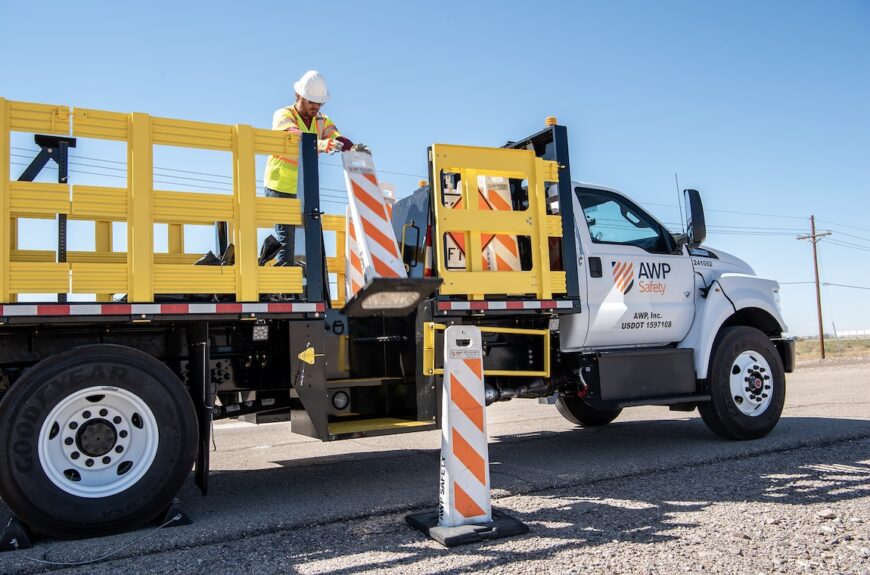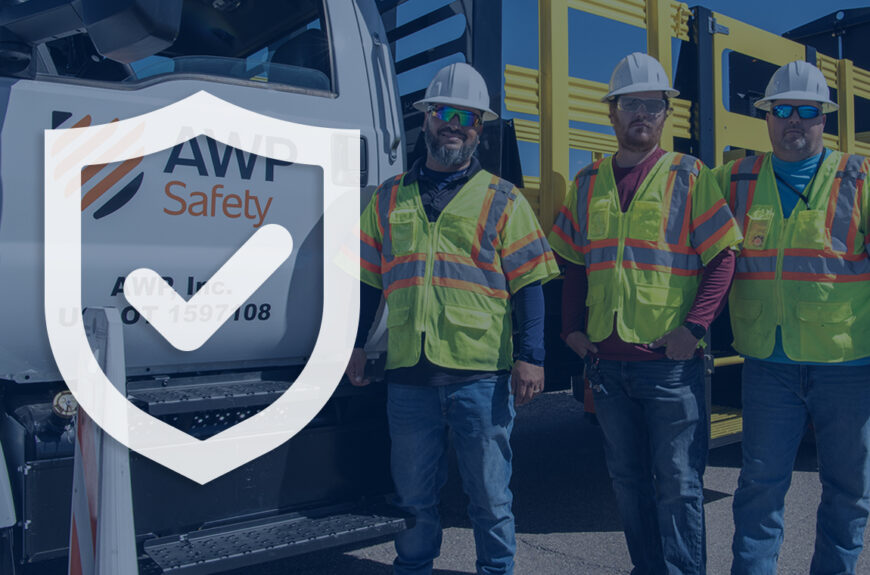
VP Of Safety Speaks on Using Training and Technology
Mark Ludewig, vice president of Safety for AWP Safety, shared how safety training and technology can benefit construction work zones in his Work Truck online article, “Using Training and Tech to Transform Driver Habits“.
As construction season is upon us, it is important to recognize the safety concerns of large-truck-related incidents occurring on our roads, and take the necessary precautions to prevent future incidents. The transportation industry is facing a concerning trend in the safety of large truck operations.
In 2021, a significant escalation in crashes involving large trucks was recorded, with 5,700 incidents leading to fatalities—an 18% rise from 2020 and a staggering 49% increase over the last decade. These National Safety Council (NSC) statistics include both commercial and noncommercial vehicles with a gross vehicle weight rating over 10,000 pounds, excluding buses and motor homes. Moreover, the year witnessed 117,300 large trucks involved in injury-inducing crashes, marking a 12% uptick from 2020.
The alarming statistics point to a broader industry-wide issue, necessitating a reevaluation of safety protocols and measures to curb this rising tide of large-truck-related incidents on our roads. AWP Safety emphasizes the pivotal importance of customized training and in-vehicle technology advancements in mitigating such risks.
In the Work Truck article, Mark highlights key components of safety training for work truck operators and shares how intelligent electronic systems and software can improve safety, both during the busy construction period and throughout the year.
Safety Training Essentials For Work Truck Operators
Ensuring the safety of work truck operators requires comprehensive, job-specific training programs that go beyond basic road safety guidelines, addressing the unique and complex challenges of managing large and cumbersome work trucks. Fleet operators can find the necessary training programs through a variety of channels, including specialized safety partners like AWP Safety, and industry associations like ATTSA. In-depth training essentials include:
- Defensive Driving — This module aims to provide drivers with advanced situational awareness skills, enabling them to anticipate and skillfully navigate through potential road hazards.
- Construction Zone Navigation — This segment of training covers a comprehensive understanding of the construction signage, the ability to interpret and respond to the directions of on-site personnel effectively, and the skills to maneuver large vehicles in confined spaces with limited visibility.
- Load and Equipment Handling — This training component focuses on the correct procedures for loading, securing and unloading equipment, as well as mitigating the risks of shifting or dislodging cargo. It delves into the principles of weight distribution within the vehicle, educating drivers on how different operational scenarios and loading configurations can influence the truck’s handling and stability.
- Emergency Response — This critical training prepares drivers to face unforeseen events with confidence and competence. It encompasses a broad spectrum of emergency scenarios and also includes basic first-aid training, rudimentary vehicle repair techniques and the protocols for effective emergency communication.
Technological Solutions: The Future of Worksite Safety
Incorporating emergent technologies into vehicles plays a pivotal role in perseverance of worksite safety. By leveraging today’s digital tools, drivers are better equipped to respond to dynamic road conditions and potential hazards, thereby fostering a safer driving environment. Key safety integrations include:
- Advanced Driver-Assistance Systems (ADAS) — ADAS offers a variety of features designed to augment human capabilities. Automatic emergency enables vehicles to respond to imminent collisions faster than human reflexes, significantly reducing the severity of accidents or averting them altogether. Adaptive cruise control and lane-keeping assistance are two additional technologies that vigilantly help correct behaviors and prevent unintended accidents.
- Telematics and Fleet Management Systems — The advent of telematics has revolutionized fleet management. These systems meticulously record and analyze speed, acceleration patterns and braking behaviors, providing fleet managers with actionable insights to enforce safety protocols. Moreover, they enable optimized route planning, factoring in real-time traffic conditions and road work.
- 360-Degree Camera Systems — These camera systems offer an unobstructed panoramic view of the vehicle’s immediate surroundings. The comprehensive visual is instrumental in avoiding collisions with obstructions, equipment, and personnel, helping to ensure safe maneuverability in tight spaces.
- Blind Spot Detection — The structural design of work trucks inherently creates substantial blind spots. Blind spot detection systems serve as an electronic sentinel, monitoring these vulnerable areas and alerting drivers to the presence of other vehicles or objects.
- Stability Control Systems — Stability control systems continuously monitor vehicle dynamics and in critical situations, autonomously adjust engine output and apply targeted braking to individual wheels, maintaining vehicular stability and averting potential overturns.
Driving Efficiency & Safety through Software
AWP Safety is utilizing customizable software to enhance road safety and better manage its specialized vehicle fleet. A central part of this approach involves adopting Derive VQ fleet management technology that reduces vehicle idle times and fine-tunes automatic transmission settings for improved fuel efficiency. The result is a notable decrease in fuel use and emissions, contributing to lower costs and more eco-conscious fleet operations.
The technology also features a speed control function that prevents vehicles from exceeding AWP’s established speed limits, eliminating the possibility of drivers, even inadvertently, speeding.
Improving EHSQ Practices for Work Truck Fleets
For work truck fleet owners looking to enhance both the safety and efficiency of their operations, integrating environmental, health, safety, and quality (EHSQ) strategies is key. By leveraging cloud-based digital solutions, these strategies allow for real-time monitoring, analysis, and implementation of safety and quality protocols. Cloud platforms also facilitate instant updates and the distribution of critical information across the fleet.
Safety incident reporting software, a key component of EHSQ solutions, enables the efficient capture, analysis, and reporting of all safety incidents and near misses. By examining data from previous incidents in conjunction with inspection and maintenance logs, it’s possible to identify trends and risk elements, which can inform the creation of proactive safety strategies.
Embracing EHSQ software, such as Intelex solutions adopted by AWP Safety, can greatly enhance process coordination. These tools prove invaluable, especially for organizations with sprawling networks, multiple facilities, and extensive vehicle fleets, fostering a unified approach to safety and quality management.
Don’t Forget the DVIR
As a work truck fleet owner, it’s crucial to ensure that a Driver Vehicle Inspection Report (DVIR) is conducted daily for every commercial vehicle in use. This practice is not just a recommendation but a requirement under Federal Law 49 CFR 396.11 and 396.13, overseen by the United States Department of Transportation (DOT) and the Federal Motor Carrier Safety Administration (FMCSA).
Summer Heat Hazard Training
Summer’s warmth also introduces potential health risks for on-site workers. Intense heat, combined with the physically demanding nature of construction and the necessity of wearing personal protective equipment (PPE), escalates the threat of heat stress illnesses. Be sure to prioritize heat illness prevention training, allowing workers to recognize the early signs of heat stress and understand the necessary precautions to take.
A Collaborative Approach to Work Truck Safety
By integrating targeted safety training, in-vehicle technologies, and data-centric platforms for ongoing improvements, the hazards faced by work truck drivers and construction workers can be significantly reduced. The success of these initiatives requires a collaborative effort from drivers, employers, and educational bodies. Together, we can ensure that work truck drivers remain safe on the roads, contributing to the overall safety of our roadways during the busiest times of the year.
To read Mark’s full article, visit Work Truck online.



